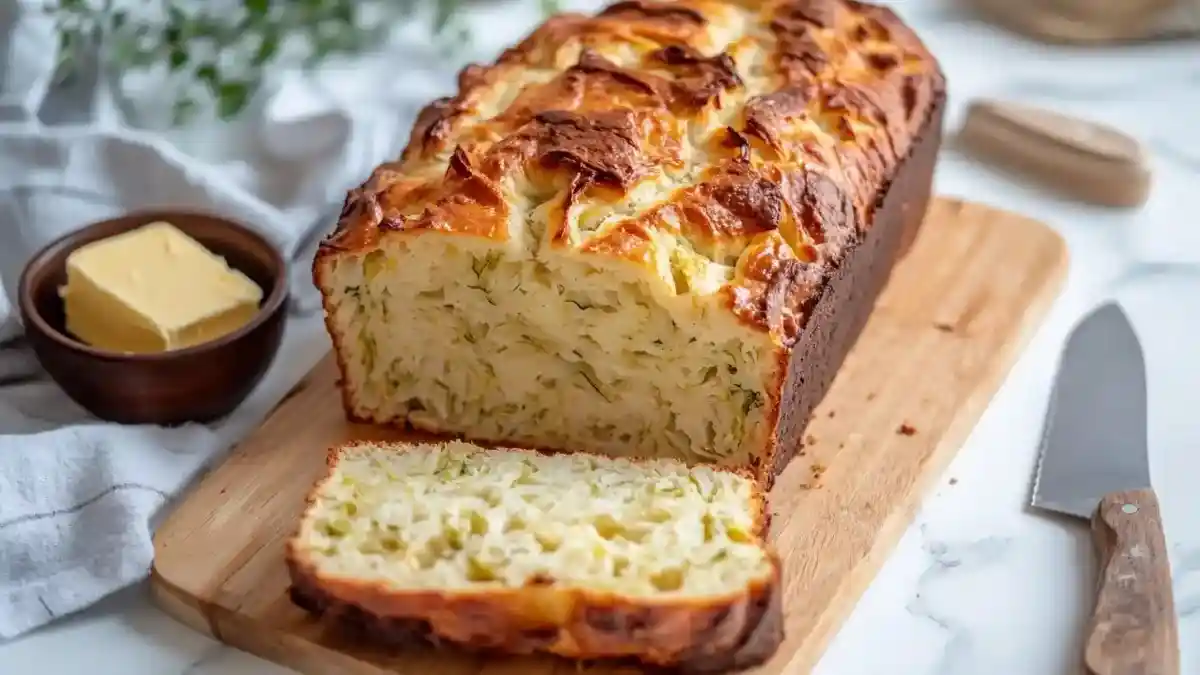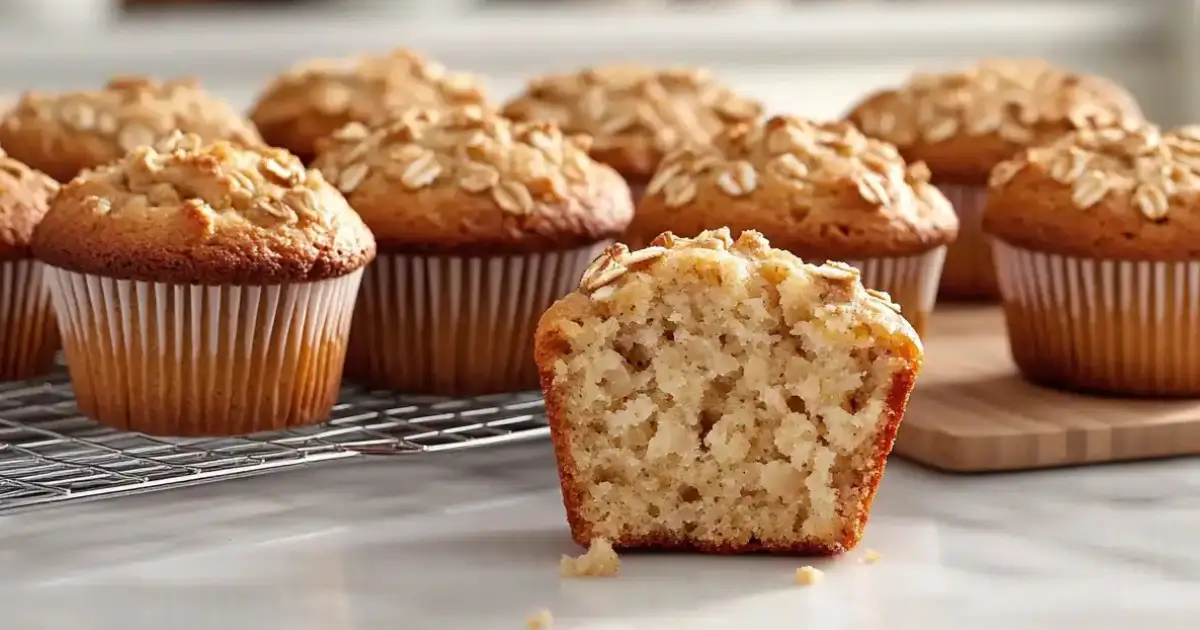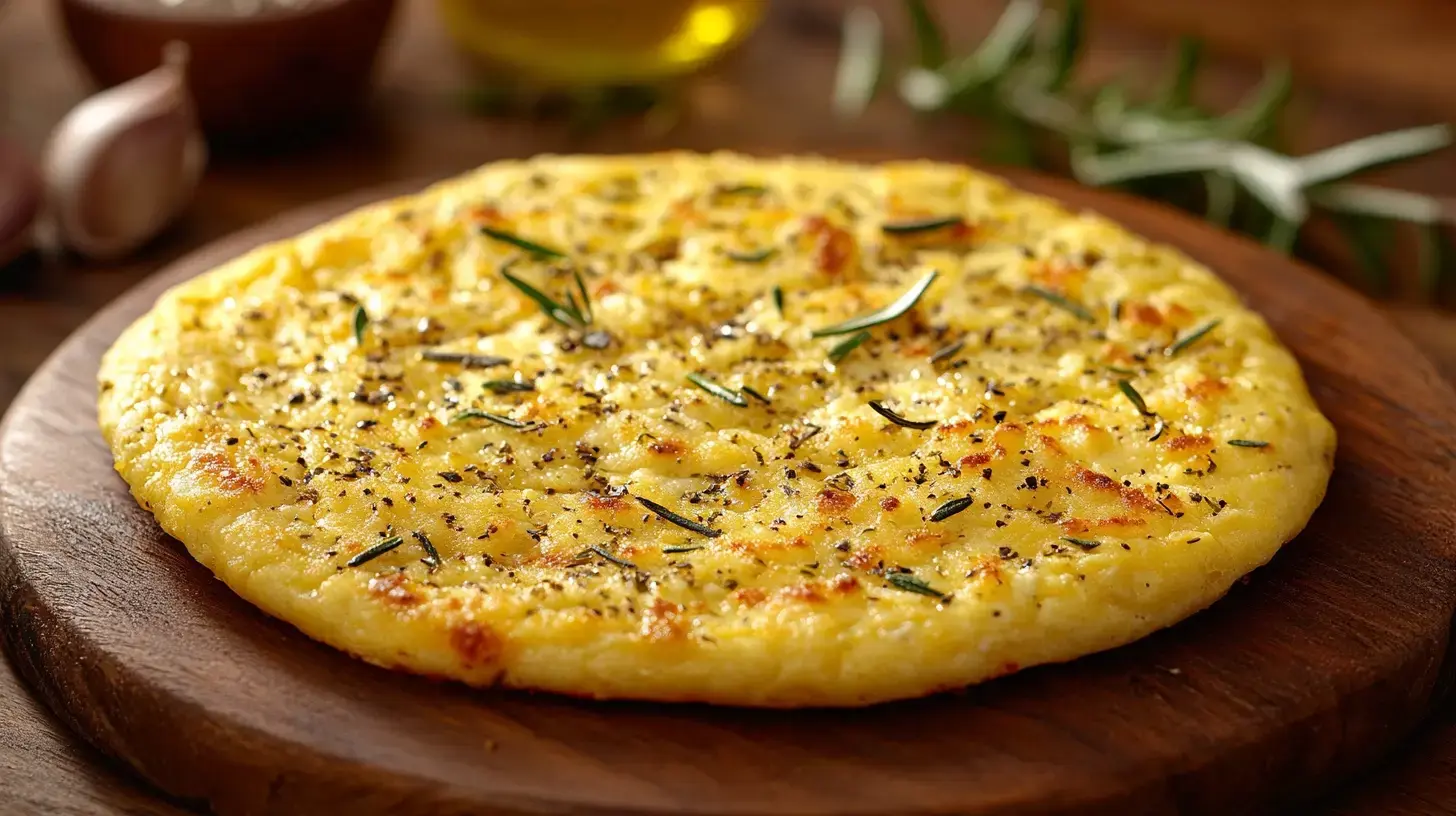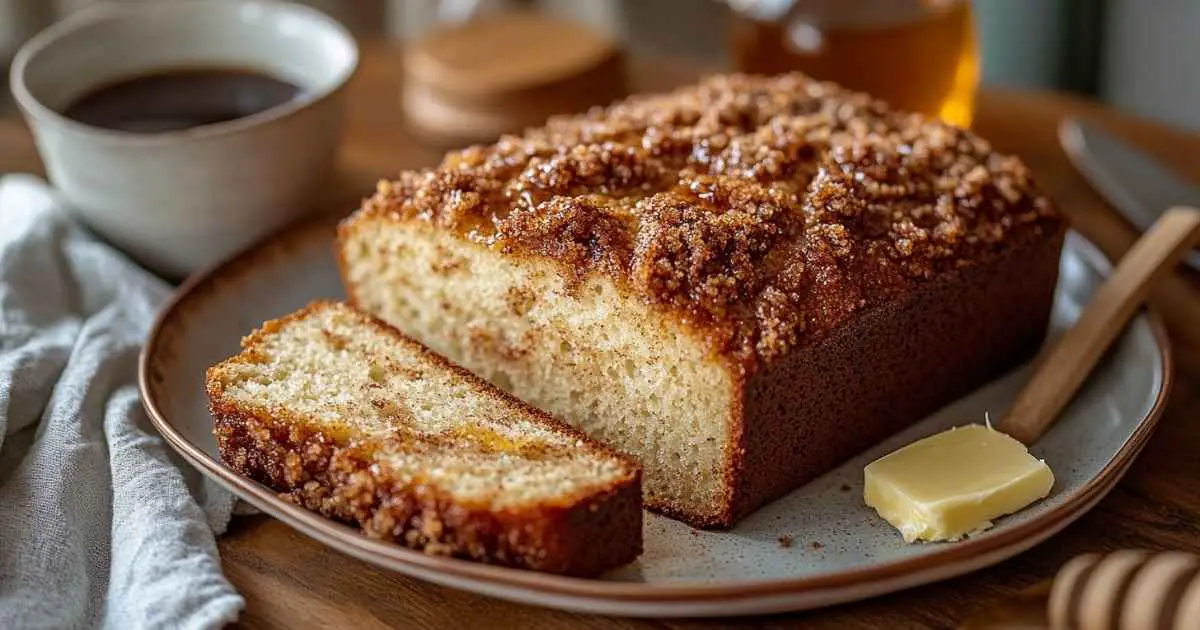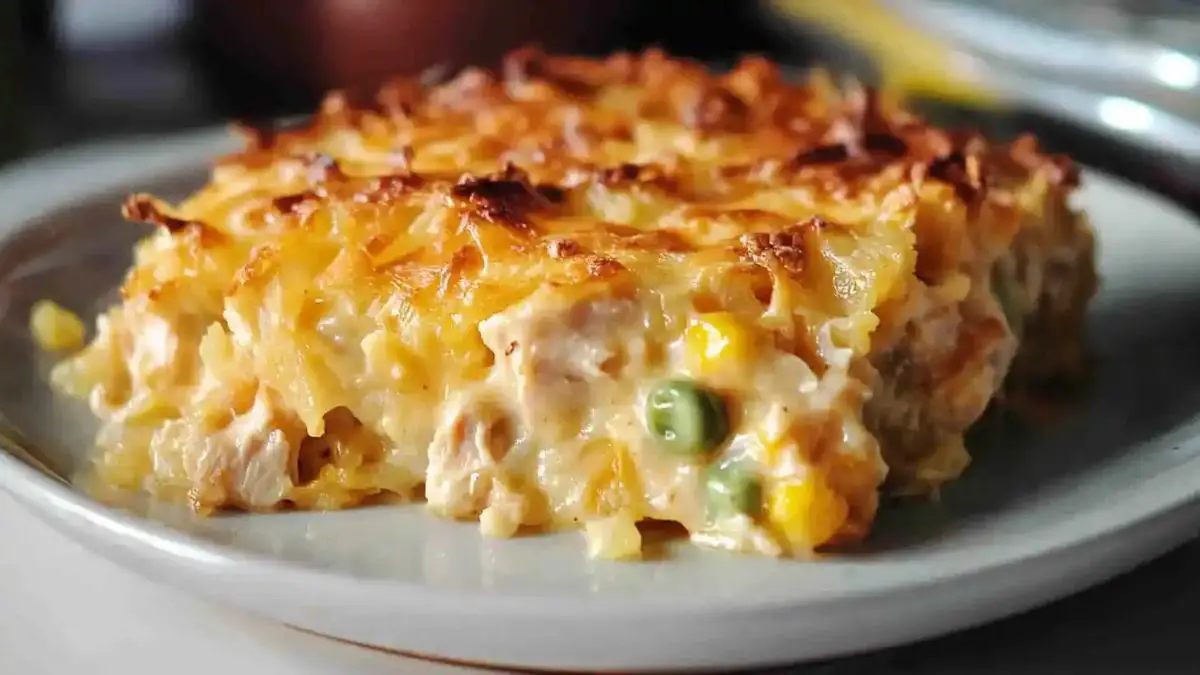Cabbage bread is a fun and creative twist on regular bread, offering a lighter alternative that fits many diets. This cabbage bread recipe pairs the wholesome taste of cabbage with simple baking steps, creating a tender loaf that works for sandwiches or as a side dish. You’ll love its mild flavor and soft texture, which complement plenty of spreads and toppings.
This dish has roots in traditional veggie-based breads and has grown in popularity due to its low-carb benefits. Give it a try at home—you’ll see why it’s so popular among those looking for a new way to enjoy bread.
Why You’ll Love This Recipe
This recipe shines because it’s straightforward and adaptable. You don’t need advanced baking skills or fancy tools—just basic ingredients and a standard oven. It’s also a lower-carb choice, making it appealing if you want to enjoy bread without a heavy serving of flour.
The subtle sweetness of cabbage adds a unique taste that stands out from typical loaves, and the texture stays soft, making it perfect for sandwiches or simple toast. Plus, you can customize it by adding herbs, seeds, or your favorite spices. This cabbage bread recipe can quickly become a staple in your kitchen if you’re looking for a fresh and healthy spin on homemade bread.
Ingredients for Cabbage Bread Recipe
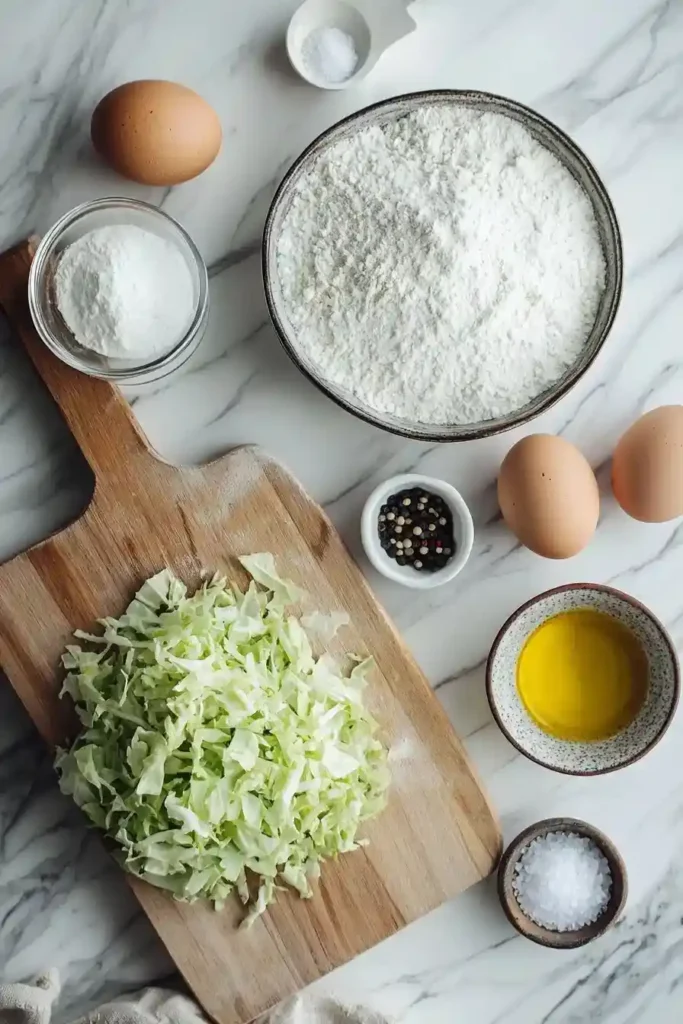
Below is a clear list of items you’ll need. Gather them ahead of time so everything is ready when you begin.
- Cabbage (about 2 cups shredded) – Use green or savoy cabbage. Shred it finely.
- Eggs (2 large) – These bind the mixture and add moisture.
- All-Purpose Flour (1 cup) – You can also use a gluten-free blend if you prefer.
- Baking Soda (1 teaspoon) – Also known as bread soda in some regions, for extra lift.
- Salt (1 teaspoon) – Adjust to taste.
- Black Pepper (½ teaspoon) – You can use more or less as you like.
- Olive Oil (2 tablespoons) – A small amount of oil keeps the bread soft.
- Warm Water (¼ cup, if needed) – Helps the dough reach the right consistency.
- Optional Add-Ons – Herbs like rosemary or thyme, seeds like flax or chia, or a sprinkle of shredded cheese if you want extra flavor.
These core ingredients keep the recipe simple yet flavorful. Make sure your cabbage is well-drained after shredding to avoid excess moisture.
How to Make Cabbage Bread Recipe (Step by Step)
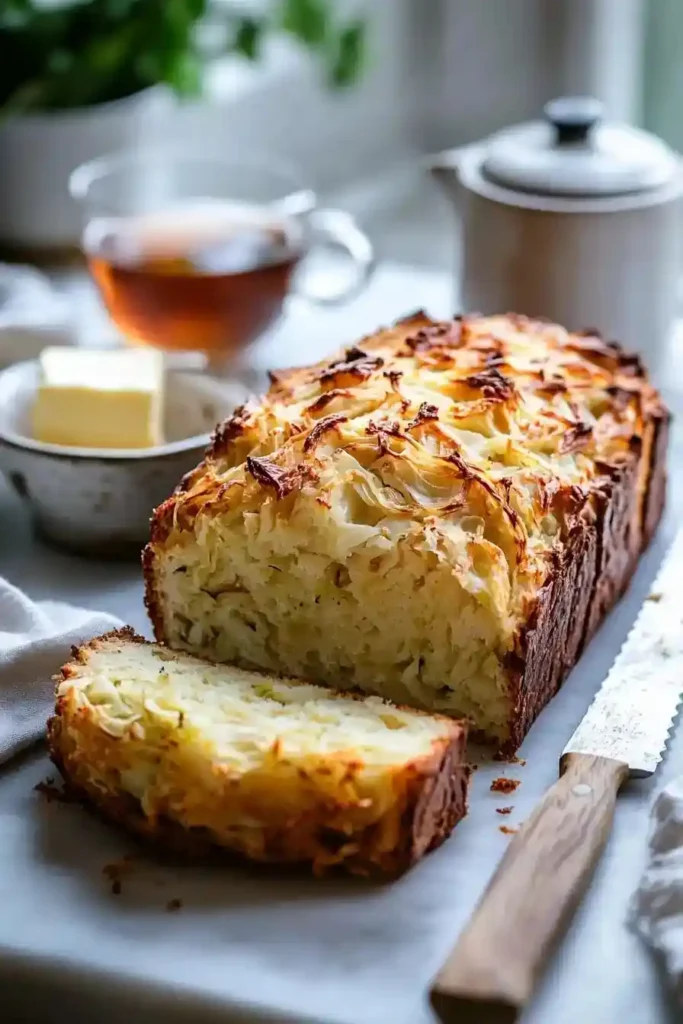
Below is a detailed guide that will help you create a tasty cabbage bread without confusion. Follow each step carefully, and remember to adjust seasonings to your liking.
- Prepare the Cabbage
- Start by washing your cabbage head under cool water.
- Pat it dry with a clean kitchen towel.
- Use a sharp knife or a grater to shred the cabbage finely. Aim for about 2 cups of shredded cabbage.
- If you want a smoother texture, chop any large strands into smaller pieces. This makes the dough easier to mix later.
- Lightly sprinkle the shredded cabbage with a pinch of salt, then place it in a strainer. Let it sit for around 10 minutes to remove extra moisture.
- Soften the Cabbage (Optional Step)
- Some people prefer to cook the cabbage lightly before adding it to the dough.
- If you want to do this, warm a skillet on medium heat. Drizzle in 1 teaspoon of olive oil, then add the shredded cabbage.
- Sauté for around 3–5 minutes until it softens. You don’t need to brown it—just let it become slightly tender.
- Remove the cabbage from the heat and let it cool. This step can reduce the strong cabbage flavor if you prefer a milder taste in your bread.
- Combine Dry Ingredients
- In a large mixing bowl, stir together the all-purpose flour, baking soda, salt, and black pepper.
- Make sure these ingredients are blended well to avoid any lumps of baking soda in one spot.
- If you’re adding herbs or spices like paprika, garlic powder, or dried oregano, mix them in at this stage.
- Beat the Eggs
- Crack two large eggs into a separate small bowl.
- Use a whisk or fork to beat them until the yolks and whites are blended.
- Keep whisking for about 30 seconds to add a bit of air. This step helps create a lighter final texture.
- Form the Dough
- Make a small well in the center of your dry ingredients.
- Pour in the beaten eggs and two tablespoons of olive oil.
- Stir gently with a wooden spoon or spatula.
- If the mixture looks too dry, add warm water a little at a time. You want a soft, slightly tacky dough, not runny.
- If it’s too wet, add a small sprinkle of extra flour.
- Once it starts to hold together, switch to using your hands to knead lightly in the bowl.
- Incorporate the Cabbage
- Gently fold in the shredded cabbage. If you sautéed it earlier, make sure it’s at room temperature.
- Distribute it evenly through the dough. This might take a few minutes of light kneading.
- Aim for a cohesive dough where the cabbage is visible but not clumped in one spot.
- Rest the Dough
- Form the dough into a loose ball and leave it in the bowl.
- Cover the top with a clean cloth or plastic wrap.
- Let it rest for about 10–15 minutes. This short rest makes the dough easier to shape later.
- If your kitchen is very warm, you can keep it in a slightly cooler spot to avoid overproofing.
- Shape the Bread
- After resting, place the dough on a lightly floured surface.
- Shape it into a round or oval loaf, depending on your preference.
- Alternatively, you can form smaller rolls if you want single-serving portions.
- Lightly press the surface to remove any large air pockets. Don’t press too hard—you still want some air in the dough for a nice crumb.
- Prepare Your Baking Pan
- Line a baking sheet with parchment paper or lightly grease it.
- Place the shaped dough on the sheet. If you made smaller rolls, space them out so they don’t touch.
- You can score the top with a sharp knife to allow for expansion. A quick slash or two will help.
- Bake
- Preheat your oven to 375°F (190°C).
- Once hot, slide your baking sheet onto the middle rack.
- Bake for around 25–35 minutes, depending on your oven and loaf size. Smaller rolls can take about 20–25 minutes, while a larger loaf may need closer to 35 minutes.
- The cabbage bread is done when the crust turns golden brown and a tap on the bottom sounds a bit hollow.
- Cool and Serve
- Take the bread out of the oven and let it sit on a cooling rack for at least 10 minutes before slicing.
- This step helps the inside set and makes slicing much easier.
- Slice it up and enjoy plain, or top with your favorite spreads like avocado or soft cheese.
With these steps, you’ll have a warm loaf of cabbage bread that combines a gentle veggie flavor with the satisfying texture of homemade bread.
Serving and Storage Tips
Serving Suggestions
- Classic Toast: Toast slices lightly, then add butter or your preferred spread. This bread’s cabbage undertone pairs well with creamy toppings.
- Sandwich: Turn it into a tasty sandwich with sliced turkey, roasted veggies, or a fresh avocado spread. The hint of cabbage flavor boosts the overall taste without overpowering other fillings.
- Side Dish: Use it to complement soups, stews, or salads. A warm slice of cabbage bread on the side can turn a simple meal into something more special.
Storage
- Room Temperature: You can keep it at room temperature for about 2 days in an airtight container or a sealed plastic bag. Make sure it’s cool before you seal it to prevent trapped moisture.
- Refrigerator: Store leftover cabbage bread in the fridge if you live in a warm climate or want it to last a bit longer. It will keep fresh for about 3–4 days.
- Freezer: Wrap slices in plastic wrap or foil, then place them in a freezer-safe bag. They can stay in the freezer for up to 2–3 months. When you’re ready to eat, thaw the slices overnight in the fridge or use a microwave’s defrost setting.
Reheating
- Toaster: For single slices, a toaster is the easiest choice.
- Oven: If you’re reheating multiple slices, place them on a baking sheet and warm in a 350°F (180°C) oven for about 5–7 minutes.
- Microwave: It works in a pinch, but the bread may turn a bit chewy. Warm it in short bursts (10–15 seconds) until it’s just heated.
USDA Freezing and Food Safety: This guide offers comprehensive information on best practices for freezing foods, ensuring safety and quality.
Helpful Notes
- Flour Alternatives: If you need a gluten-free version, swap the regular flour for a 1:1 gluten-free baking blend or almond flour. Keep an eye on moisture levels, as some gluten-free mixes absorb liquid differently.
- Cabbage Prep: Make sure to get rid of extra moisture. If your shredded cabbage is very wet, your dough can become too sticky. Pat it dry or sauté it briefly.
- Seasoning Ideas: Feel free to add ingredients like garlic powder, onion powder, dried parsley, or dill. These add a pop of flavor without complicating the recipe.
- Texture Tips: Baking soda (sometimes referred to as bread soda) helps lighten the loaf. If you notice your bread is dense, check that your baking soda hasn’t expired. Fresh leavening agents are key for a good rise.
- Resting Period: A brief rest for the dough helps the gluten relax. If you skip it, the bread might be a bit chewy. Ten to fifteen minutes should be enough.
- Portion Control: You can make small rolls if you want individual servings. Adjust baking time accordingly, since smaller pieces cook faster.
- Dietary Benefits: Cabbage is a cruciferous vegetable with vitamins, minerals, and antioxidants. According to the Brown University Health., cabbage can be a nutritious addition to meals. It contains vitamin C and fiber, helping you feel satisfied without relying on processed carbs.
- Taste and Smell: Warm cabbage has a gentle aroma, but it won’t overpower the bread’s main flavor. If you’re worried about a strong veggie taste, consider sautéing it first or mixing in fresh herbs.
- Versatility: Cabbage bread can serve as a unique base for many dishes. Use it for savory toast with toppings like tomatoes or cheese, or slice it into sticks to dip in soup.
- Customization: Try sprinkling sesame seeds or sunflower seeds on top for extra crunch. You can also brush an egg wash on the crust for a shiny finish.
Remember: Quality ingredients make a big difference in taste and texture. Fresh cabbage, good flour, and the right seasonings will give you a loaf that’s memorable and satisfying.
Conclusion
Cabbage bread may sound unusual at first, but it’s a fun way to enjoy a veggie-based loaf that balances simple flavors with a soft crumb. With everyday ingredients, you can create a bread that stands apart from conventional recipes. The gentle hint of cabbage brings moisture and a mild flavor boost, making it perfect for toast, sandwiches, and as a side dish with lunch or dinner. It’s also a clever way to reduce flour intake while still enjoying the comforts of bread.
Once you’ve tried this cabbage bread recipe, you’ll see how easy and versatile it is. Feel free to leave a comment about your experience or any changes you made. Your feedback can help others discover new ways to enjoy this recipe. Share pictures on social platforms if you want to show off your homemade success. Enjoy!
___________________________________
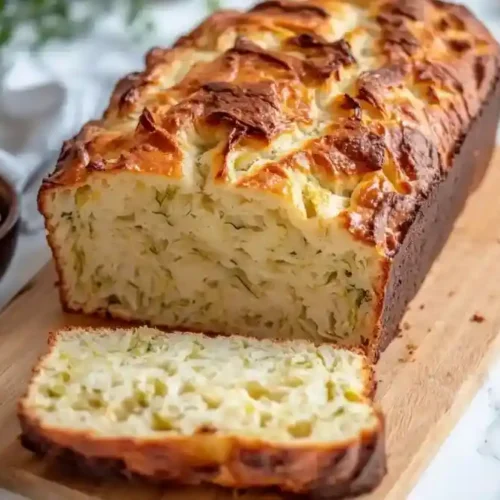
Cabbage Bread Recipe
Equipment
- Mixing Bowl
- Baking Sheet
- Parchment Paper
- Oven
Ingredients
Cabbage Bread Dough
- 2 cups shredded cabbage finely shredded, green or savoy
- 2 large eggs
- 1 cup all-purpose flour or gluten-free blend
- 1 tsp baking soda also known as bread soda
- 1 tsp salt adjust to taste
- 1/2 tsp black pepper adjust to taste
- 2 tbsp olive oil adds moisture
- 1/4 cup warm water if needed for consistency
Optional Add-Ons
- rosemary or thyme herbs for extra flavor
- flax or chia seeds for added nutrition
- shredded cheese for extra flavor boost
Instructions
- Wash and pat dry the cabbage. Shred it finely using a grater or sharp knife.
- Lightly salt the cabbage and let it sit for 10 minutes to release excess moisture. Squeeze out any remaining liquid.
- In a large bowl, combine flour, baking soda, salt, and black pepper.
- Beat eggs in a separate bowl, then add olive oil and mix well.
- Make a well in the dry ingredients and pour in the egg mixture. Stir gently.
- Gradually add the shredded cabbage, folding it into the mixture.
- If the dough is too dry, add warm water one tablespoon at a time.
- Let the dough rest for 10-15 minutes to allow ingredients to blend.
- Preheat the oven to 375°F (190°C). Line a baking sheet with parchment paper.
- Shape the dough into a round loaf or small rolls and place on the baking sheet.
- Bake for 25-35 minutes until golden brown and sounds hollow when tapped.
- Let cool for 10 minutes before slicing and serving.
Notes
- Calories: 140 kcal
- Fat: 6g
- Protein: 5g
- Carbohydrates: 15g
- Fiber: 3g
- Sugar: 2g
- Sodium: 250mg
Explore More Delicious Recipes
If you enjoyed exploring the Cabbage Bread Recipe, why not delve into more delightful dishes from our collection? Here are some must-try breakfast recipes to elevate your cooking adventures:
- Jammy Eggs Recipe
- Pumpkin Pancake Recipe
- Pancake Bread Recipe
- Cinnamon Roll French Toast
- Cherry Scones Recipe
Explore these recipes today to bring more exciting flavors to your table and make every meal memorable!
FAQs
1. What is the healthiest way to eat cabbage?
Steaming or lightly sautéing cabbage is a popular way to retain nutrients and color. Some prefer raw cabbage in salads for its crunchy texture. Raw cabbage offers a high vitamin C content, but gently cooking it can improve digestibility for some people. If you use it in cabbage bread, you still get many of its vitamins and minerals, though a bit of heat may reduce certain nutrients. The healthiest choice depends on your personal preference and tolerance. For additional guidance, you can explore health resources like the Brown University Health.
2. Why do you put vinegar in cabbage?
Many cabbage dishes call for vinegar to balance the natural sweetness of the vegetable. The tangy flavor brings out a bright taste that complements cabbage’s mild profile. Vinegar can also help the cabbage maintain a more vibrant color in certain recipes. In classic coleslaw, for instance, a small splash of vinegar adds a zesty edge. You don’t need vinegar in every recipe. In cabbage bread, it’s optional, but a slight acidic note can liven up the flavor if you want a sharper taste.
3. How to store cabbage bread?
Cabbage bread should be cooled fully before storage. You can keep it at room temperature for a couple of days in an airtight container or sealed plastic bag. If you want it to last longer, place it in the fridge for up to four days. Make sure to wrap it well to prevent dryness. If you’d like to store it for even longer, slice the bread and freeze it in a freezer-safe bag. You can defrost slices as needed, either in the fridge or on a low setting in the microwave.
4. What does bread soda do to cabbage?
Bread soda, which is another name for baking soda, helps the dough rise and develop a lighter texture. When used with cabbage in the bread mixture, it encourages some lift, so your loaf doesn’t become too dense. It also balances acidity, especially if you include a small dash of vinegar or acidic ingredients. Bread soda won’t drastically change the cabbage itself, but it helps the overall bread texture stay airy and pleasant to chew.
5. Is it OK to eat raw cabbage every day?
Raw cabbage can be a healthy addition to meals because it supplies vitamins, minerals, and dietary fiber. Many people enjoy it shredded in salads or as a crunchy topping. Daily consumption of raw cabbage is usually fine for most individuals, but some people may experience bloating or gas. If you have a sensitive stomach, you might want to alternate between raw and cooked forms. As always, if you have concerns about how certain foods affect you, consult a nutrition professional or healthcare provider for personalized advice.
6. Is cabbage good or bad for your stomach?
Cabbage can benefit digestion because it contains fiber, which supports a healthy gut. However, some people experience gas or discomfort when they eat too much of it, especially if it’s raw. Cooking can lower the risk of bloating by making cabbage easier to break down. In moderate amounts, cabbage is generally considered good for most stomachs. It’s also linked with beneficial compounds that may help overall health, but individual responses vary. If you feel any discomfort, adjust your portion sizes or try different cooking methods until you find what works best for you.

